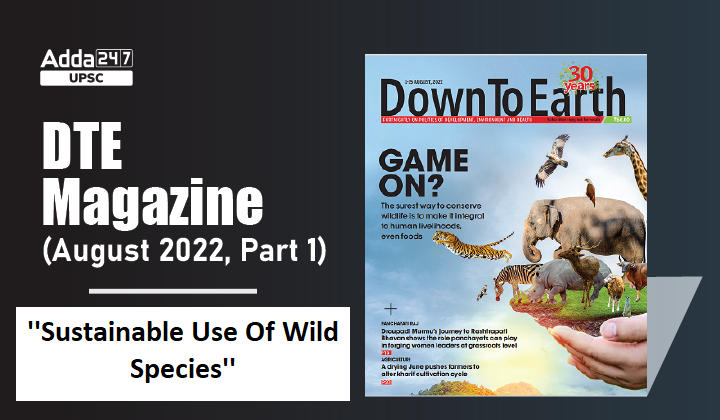Table of Contents
Down To Earth Magazine is a fortnightly magazine focusing on politics of environment and development, published in New Delhi, India.
UPSC Previous years’ questions on Development, Environment, Health and Disaster Management give us a clear idea about the increased importance of Down To Earth Magazine.
Down To Earth Magazine is one of the most important and indispensable source for UPSC Civil Services Exam Preparation. Keeping this in mind, here, we come with ”Gist Of Down To Earth Magazine” which covers important environmental current affairs articles in smooth pointed form, keeping in mind the demand of UPSC aspirants.
Sustainable Use Of Wild Species: Introduction
- The intergovernmental body IPBES released the summary of its much-awaited “Assessment Report on the Sustainable Use of Wild Species” on July 8.
- According to this report, sustainable use of wildlife is the best approach to conservation in the long run.
- It says that the optimal exploitation of wild flora and fauna will ensure that the livelihood and dietary needs of humans are met without threatening survival of the species.
What is IPBES?
- The Intergovernmental Science-Policy Platform on Biodiversity and Ecosystem Services (IPBES) is an independent intergovernmental body established by States to strengthen the science-policy interface for biodiversity and ecosystem services for the conservation and sustainable use of biodiversity, long-term human well-being and sustainable development.
- It was established in Panama City, on 21 April 2012 by 94 Governments.
- It is not a United Nations body. However, at the request of the IPBES Plenary and with the authorization of the UNEP Governing Council in 2013, the United Nations Environment Programme (UNEP) provides secretariat services to IPBES.
Sustainable Use Of Wild Species: How old is the concept?
- Sustainable use of wildlife is not a new concept. A 2022 paper in Frontiers in Conservation Science says the idea dates to the 1600s.
- But it was only in the mid-1800s and more actively since the 1960s that legal frameworks for wildlife management emerged.
Sustainable Use Of Wild Species: Summary of IPBES Report
Suggesting greater integration of species conservation and food security, the summary states that:
- Billions of people worldwide rely on some 50,000 wild species for food, energy, medicine and income. Roughly, 33,000 of the species are plants and fungi; 7,500 are fish and aquatic invertebrates; and 9,000 are amphibians, insects, reptiles, birds and mammals.
- Of these, more than 10,000 species are used directly for human food.
- Sustainable use of the wild species is, therefore, fundamental to maintaining biodiversity and ecosystem functions in the long term, while achieving food security and improving nutrition across the globe.
- About 70 per cent of the world’s poor directly depend on wild species for survival. In many cases, wild species are symbols of cultural identities.
Sustainable Use Of Wild Species: How would it help in bolstering the UN’s SDGs?
- Sustainable use of wild species would bolster the UN’s Sustainable Development Goals (SDGs).
- It can help achieve 80 per cent of the SDG 1 and SDG 2 goals each that aim at eradicating poverty and hunger.
- This is apart from contributing to the achievement of 15 other SDGs that include ensuring good health and well-being; reducing inequality; providing access to affordable clean energy; and promoting economic growth.
Sustainable Use Of Wild Species: Importance Of IPBES Assessment
- The assessment was in part conducted at the request of the Convention on International Trade in Endangered Species of Wild Fauna and Flora (CITES), a treaty to ensure that the global trade in plants and animals does not imperil their survival in the wild.
- The parties to CITES will use the findings from the assessment to amend conservation policies at their conference in Panama, US, in November this year.
- The assessment will also influence policy declarations by the International Whaling Commission, Ramsar Convention on Wetlands and the UN’s Convention on Biological Diversity (CBD) which are scheduled for later this year.
- Experts believe that the outcomes of the CITES conference will play a major role in the drafting of the post-2020 Global Biodiversity Framework, which is being prepared by CBD.
- This will help prepare a scientific base for the conservation of biological resources over the coming decades till 2050.



 TSPSC Group 1 Question Paper 2024, Downl...
TSPSC Group 1 Question Paper 2024, Downl...
 TSPSC Group 1 Answer key 2024 Out, Downl...
TSPSC Group 1 Answer key 2024 Out, Downl...
 UPSC Prelims 2024 Question Paper, Downlo...
UPSC Prelims 2024 Question Paper, Downlo...
